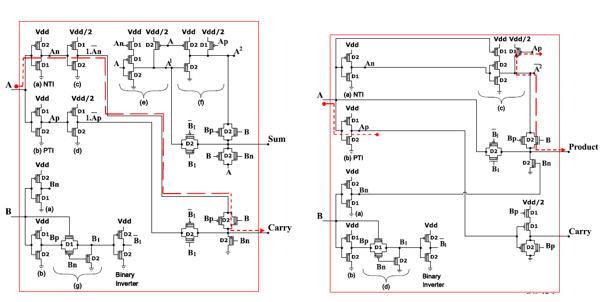Novel Ternary Adder and Multiplier Designs Without Using Decoders or Encoders
Objective
In this project, the 32 nm CNTFET-based Ternary Half Adder (THA) and Multiplier (TMUL) circuits use novel ternary unary operator circuits and implement two power supplies Vdd and Vdd/2 without using any ternary decoders, basic logic gates, or encoders to minimize the number of used transistors and improve the energy efficiency.
Abstract
In this project, the 32 nm CNTFET-based Ternary Half Adder (THA) and Multiplier (TMUL) circuits use novel ternary unary operator circuits and implement two power supplies Vdd and Vdd/2 without using any ternary decoders, basic logic gates, or encoders to minimize the number of used transistors and improve the energy efficiency. Multiple-Valued Logic systems present significant improvements in terms of energy consumption over binary logic systems. This paper proposes new ternary combinational digital circuits that reduce energy consumption in low-power nano-scale embedded systems and Internet of Thing (IoT) devices to save their battery consumption.
NOTE: Without the concern of our team, please don't submit to the college. This Abstract varies based on student requirements.
Block Diagram

Specifications
Software Requirements:
- H-spice
- Technology files: 32nm
Hardware Requirements:
- Microsoft® Windows XP
- Intel® Pentium® 4 processor or Pentium 4 equivalent with SSE support
- 512 MB RAM
- 100 MB of available disk space
Learning Outcomes
In this project, the 32 nm CNTFET-based Ternary Half Adder (THA) and Multiplier (TMUL) circuits use novel ternary unary operator circuits and implement two power supplies Vdd and Vdd/2 without using any ternary decoders, basic logic gates, or encoders to minimize the number of used transistors and improve the energy efficiency. Multiple-Valued Logic systems present significant improvements in terms of energy consumption over binary logic systems. This paper proposes new ternary combinational digital circuits that reduce energy consumption in low-power nano-scale embedded systems and Internet of Thing (IoT) devices to save their battery consumption.





 Paper Publishing
Paper Publishing
